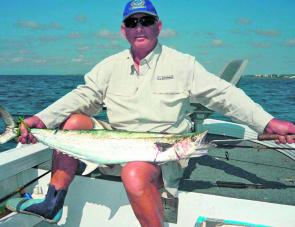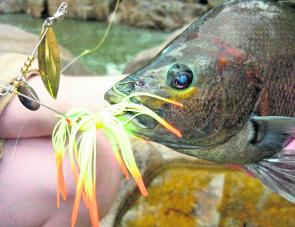The heat is well and truly on with the temps soaring, humidity increasing and the fish going bananas. Ah summer, despite the discomfort it is a great time to be on the water and it sure beats mowing the lawn.
Down in the creeks and estuaries, the big news is that jacks are hammering lures and live baits like there is no tomorrow. A 45cm+ fish is a real challenge in their natural haunt, which is right in among the snags. Sometimes you can get lucky and find one wandering a bit far from cover but that is a rarity. Most times you will need to be right hard against the rocks/snags to get a hit and, if not prepared with a locked drag, the end result will be a look of disbelief, busted off and another lure gone west! Great fun!
Jacks and their cousins, fingermark, are probably the number one creek target during the closed barra season, and mostly the spots fished for jacks don’t turn up many barras but any that are hooked should be immediately released so they can grow a bit more before February opening day. Barra will quite happily mooch around on a sand or mud flat, but you will never find jacks and fingermark in that sort of territory.
Lures for the red devils in my experience should be slightly smaller than the average barra lure, and a combination of shallow and deep divers around the 75-80mm mark seem to get a very hostile reception from the fanged ones. Only use quality lures and good hooks and rings, otherwise you will be left with a smashed lure, or worse, no lure.
Floating lures are definitely my preference when chasing jacks as they can be ‘walked’ right in among the mangrove roots etc and floated over snags, if you are very careful. I have found lures like Reidy’s, Koolabungs, Mann’s Stretch 10s, Lively Lures, Tilsans, Tropic Anglers, and Richos smaller models to be quite successful for jacks and fingermark in the creeks. The best thing about these lures is they generally don’t need upgraded hooks after buying them, unlike some of the imported lures where you end up paying top dollar but then have to spend more upgrading. Stick with the well made Aussies and you can’t go too wrong.
Colours? Take your pick, but from our experience, lures with a good splash of red seem to be favoured and we have caught plenty of jacks on all red lures. Maybe they attack out of territorial instinct or perhaps, just like barra, they will happily knock off a juvenile of the same species. However, it’s more a matter of lure placement rather than colour in my opinion.
Another option worth trying is the soft plastic approach. Try to keep the weight to a minimum otherwise you will spend a lot of time trying to save lures that are snagged. Thready Busters and Transams will pull plenty of fish, but are probably better used on sunken rock bars rather than thrown into the mangrove roots. Paddle-tails will work equally as well but again watch the weights and sink rates. Prawn imitations are very successful and can usually be rigged almost weedless, which is a definite advantage as they can be thrown right into the snags.
Aren’t there some unbelievably real prawn imitations coming out now, such as the Zemek range and similar? They should prove attractive to fish and give the reliable Prawnstars a bit of competition.
Live baiters who catch plenty of jacks and fingermark, don’t use red baits. They catch good numbers on baits like prawns, herring and small gar. Again the best bet is to have the baits fresh and kicking with just enough weight to get the bait where you want it, right in front of the jack or fingermark, and hang on as they rarely refuse such an offering.
Fingermark in particular are partial to yabbies in the creeks and estuaries, as is just about anything with fins, so don’t overlook a hook loaded up with a bunch of yabbies.
Bycatch when chasing jacks will include estuary cod, pikey bream and flathead.
While the flatties are generally a more open water fish, they also love to hang near rocks and isolated snags. I have called many an estuary cod hit for a jack as they slam the lure equally as aggressively and close into the snags put up a good show, and plenty of anglers get bricked by the old cod. Watch the legal length as many in the creeks are juveniles that need a bit more time to grow.
If your passion is for a little offshore action, then December provides many treats for the small boat angler. How does three species of mackerel, two species of tuna, various trevallies, queenfish and a sprinkling of cobia sound? Pretty good, and all these can be found within a couple of kilometres of the shoreline around Mackay.
Spotted, doggie and grey mackerel are on the chew and hammering the close inshore bait schools and will take a wide range of lures, flies and baits. Most popular trolling lures are the spoons and shinies, although I find barra lures that run around 2-3m to be very effective, particularly for greys.
Soft plastics will work a treat on mackerek as well, but the attrition rate is fairly high. Although, some of the tougher plastics will manage a few fish before getting chewed to bits. The Thready Busters and Z-Man minnows seem to hold up fairly well, even to the razor teeth of the small macks.
Generally I will troll until I can find bait schools on the sounder or hook a fish. From there I prefer to drift and cast lures, or occasionally pilchards on a gang rig if I can’t get a feed on a lure. If anchored up at one of the hotspots, like the Slade Island run through or the small reefs around Seaforth, then a bit of berley will not go astray, but keep it to small amounts as with the tidal runs the berley can end up well away from the boat which defeats the purpose.
Northern blue and mac tuna are everywhere and provide great sport on reasonably light gear. I like to use about 6kg tackle with a 20kg leader and just love spinning for these fish. Cast out let the lure sink a bit and then wind like crazy, and the hits can come thick and fast! Many fail to hook up but if the fish drops the lure crank it on again, as there are usually a couple of followers – I have had up to three different hook-ups on one retrieve. Again this is great sport and once hooked these tuna really light up the afterburners. So get ready, you may well have to chase them to get some line back on the reel.
The tuna are usually pretty easy to find – use the eyes in the sky and follow the birds. Birds that are flying around desultorily are not what you want; find the ones that are wheeling and diving or travelling fast together in a straight line, as they will usually be shadowing fish or heading towards them.
Often tuna will be seen actively feeding on the surface, smashing into bait balls, slashing around the edges or sometimes coming clear of the water as they charge up from deeper water. If that doesn’t get you hyped up then check your pulse as you are likely deceased!
With the barra closed season, the action is now centred on the dams. Of our big three, Kinchant is fishing the most consistently with plenty of metre-plus fish being caught and generally released. Many are caught trolling hardbodies or large plastic paddle-tails, but there are plenty for the lure or fly caster as well. Generally casting can be done in water not suitable for the trollers, such as hard up on weed bed edges, in little inlets and over the tops of weed beds.
This dam gets lots of use by water skiers, but they obviously keep to the main dam basin, so there is still plenty of shallower stuff for the anglers to work over.
Kinchant has a justifiable reputation as a BIG fish dam and unless you are over the 120cm mark, your fish doesn’t really make the bragging mark. The best I have heard of was over 140cm, that is some fish!
The shallow areas are for the lure and fly caster and shallow running hardbodies, and plastics can be worked on top of the weeds in many areas where there is 50cm-1m of clear water above them. Poppers are also a great option with the Tango Dancers proving one of the most successful surface lures here. I will not go barra fishing without a couple of these in the tackle box. Although the original hooks are fairly strong, I have broken trebles or straightened them, so when this happens I use a heavier treble on the back and a smaller extra strong one on the front. This makes the lure sit very bum down in the water, however it also seems to help sway it while walking-the-dog.
There isn’t anything like the explosion when a big barra hammers a surface lure – not for the faint-hearted as this often happens almost beside the boat!
In the words of that famous ad for knives, ‘but wait there’s more!’ for December angling in Mackay. I haven’t touched on Teemburra and Eungella dams, both stocked with plenty of barra and mega sooties. Nor have I mentioned the freshwater creek fishing for sooties. For those with the larger trailer boats, there have been plenty of sails and small black marlin coming from the shipping channel and the reefs are all fishing well (but remember the closures).
Lastly for the land-bound anglers, the beaches have plenty of whiting, dart, a few flathead and trevally waiting for you. The whiting are also running in the Pioneer River and can be caught from the main road bridges in the centre of the city.
As always, December in Mackay offers fantastic fishing opportunities for everyone and plenty of options, so see you at the boat ramp.
Reads: 1432
Mangrove creek action is hotting up with plenty of jacks on the prowl, like this 42cm beauty nailed by Dave Frazer right in the mangrove roots.

Mackay inshore waters are running hot with plenty of small mackerel like this 90cm spottie caught near Slade Island.

Sooties will hammer almost any lure, and fresh from the water can exhibit some amazing colours.




